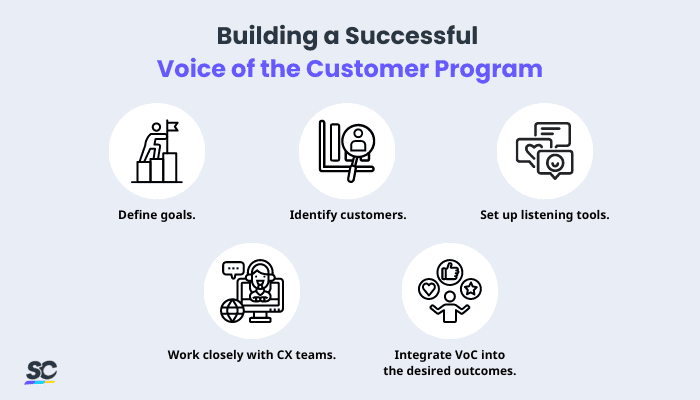What is the Voice of the Customer?
The Voice of the Customer is a research method or technique used by businesses to collect and validate customer feedback about their products and services. It’s also considered an important component of Customer Experience (CX) which focuses on the needs, expectations, and preferences of customers.
Benefits
Since the primary purpose of gathering and maximizing the Voice of the Customer data is to help businesses improve their overall CX, it’s a must for key stakeholders such as those involved in customer service and support to be passionate about customer feedback. They stand between the business and its customers, so the process of utilizing the VoC gathered through customer interactions must be well-implemented.
In the context of Quality Function Deployment (QFD), the Voice of the Customer is taken into account to implement effective action plans and strategies to address customer needs and expectations. QFD is also a tool used in integrating the VoC into an organization’s quality process, wherein the holistic methodology of Six Sigma lies. By using a product planning matrix called the House of Quality, customer requirements are obtained in the first stage of QFD.
The Six Sigma methodology’s overall purpose is to improve the quality, value, or intent of the products or services of a business. As the Voice of the Customer analysis becomes the foundation of the organization’s product life cycle and process improvement projects, the application of Six Sigma becomes more streamlined and targeted to the intended direction of how the organization can improve its processes toward stellar CX and customer service.
Conducting Voice of the Customer research and having relevant insights at your disposal also presents the following benefits to your organization:
- Competitive product innovation and optimization
- Increased customer retention and acquisition
- More opportunities for continuous improvement and business growth
- Alignment and prioritization of continuous improvement activities with customer expectations
7 VoC Data Collection Methods
Although different companies may have their own unique methods to collect VoC insights, the following is a list of the most common data collection techniques and Voice of the Customer tools:
- Customer satisfaction surveys and interviews – These can be conducted using forms, live calls, and video conferencing, among others.
- Mystery shopping program for customers – Instead of the traditional mystery shopping tactic wherein you hire people to be “mystery shoppers,” you can ask your customers to be your “secret shoppers” and record their experiences with your products and/or services.
- Focus Group Discussions (FGDs) – If you’re aiming to capture deeper, more personal responses from your customers, FGDs are a great way to expose them to an open discussion about their insights, motivations, reasons, and preferences.
- Customer calls – Recorded customer calls can also be a gold mine for garnering historical data and Voice of the Customer insights. These can give you an overview of how customers perceive your brand as a whole, along with their specific observations and suggestions they may have.
- Live chat logs – This tool can also be used to conduct customer surveys, apart from it being something that customers can use in real-time to interact with you.
- Net Promoter Score (NPS) – This is used to help you gauge how much your customers are likely to recommend your business to other people.
- Social media monitoring tools – Some Voice of the Customer examples that use these tools are the following:
- Kustomer: This tool serves as a Customer Relationship Management (CRM) platform that helps organizations access customer data and history in various channels to improve their customer satisfaction efforts.
- Hootsuite: This tool helps businesses monitor brand conversations, mentions, and even terms that customers use when saying something on social media about the product, service, or overall experience they had with the business.
Steps and Tips for Building a Successful VoC Program

Building a Successful Voice of the Customer Program
A successful VoC program must be customer-centric, aligned with the organization’s goals, and able to adapt to the changes that the business goes through. In order for these to happen, you may follow these steps and some tips for building and maintaining a VoC program that works.
Define goals.
Depending on the desired outcomes of your organization within a certain period of time, the kind of goals you need to define may vary. These goals should be able to help you to clearly set the foundation for the next steps you should take in setting up a targeted and purposeful VoC program.
For example, if you’re focusing on increased customer retention, you should look for and set up the relevant listening tools that can help you better accomplish your action plans toward that goal. In this case, you’re ensuring that the specific initiatives you’re implementing are leading to more defined objectives you can set and relay to your teams and employees toward better CX and customer service.
To better guide you, here are some questions you can ask during this step:
- What business objective are we trying to achieve using the VoC program? Is it for benchmarking or for continuous improvement?
- What do we intend to capture? Are we looking at trends, discovering customer demographics, or analyzing website visitor behavior and response?
- With our business objective and the data we must capture, what kind of tool or platform do we need to use?
Identify customers.
In this step, it’s crucial to understand first what your organization already knows about your customers. Using existing customer data, you can create customer or buyer profiles that you can utilize in effectively mapping out the customer journey. Even more, your marketing and product development strategies can also benefit from the presence of such profiles for further personalization.
Going back to the sample scenario wherein your organization aims to focus on increasing customer retention, your focus must be on your existing customers instead of new or potential ones.
Set up listening tools.
Depending on the objectives you’ve set for your VoC program, the kind of listening tools and strategies you may implement could be unique and may vary. t’s also crucial to consider what triggers you’ll use to encourage or prompt customers to share their experience with your business.
Efforts to proactively “listen” to customer feedback can be integrated into certain points within the customer journey. For example, conducting software demonstrations and organizing customer events can be effective ways to gather customer pain points, expectations, and other insights.
Work closely with CX teams.
Once you have a significant amount of VoC data ready for analysis, it’s imperative to ensure that the whole organization is committed to establishing goals and action plans to achieve a successful VoC program.
Commonly, the employees and leaders in the customer support and customer service teams are the ones who must be more involved in building the VoC program. Also, the leaders and teams in charge of approving and making changes to the current CX processes must be on board with the program.
Create Your Own Voice of the Customer Template
Eliminate manual tasks and streamline your operations.
Get started for FREEIntegrate VoC into the desired outcomes.
Lastly, knowing what to measure also contributes to creating a program that seamlessly integrates your VoC data into what your efforts aim to achieve. Using standard metrics like Customer Satisfaction (CSAT) and Net Promoter Score (NPS) gives you a quantitative way of measuring customer interactions and if these are improving based on the VoC program you created.



